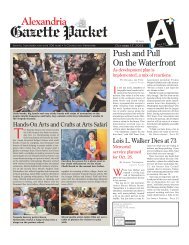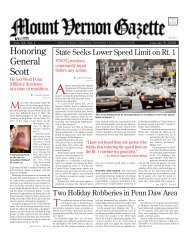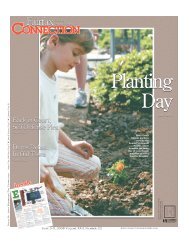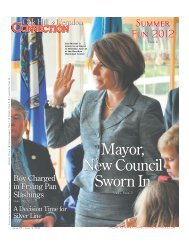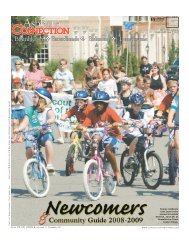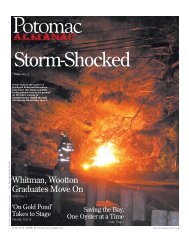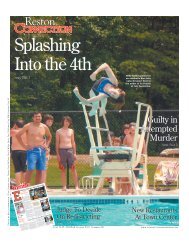Herndon - The Connection Newspapers
Herndon - The Connection Newspapers
Herndon - The Connection Newspapers
Create successful ePaper yourself
Turn your PDF publications into a flip-book with our unique Google optimized e-Paper software.
www.<strong>Connection</strong><strong>Newspapers</strong>.com<br />
News<br />
A Voice for the Voiceless<br />
Q&A with SALT<br />
Coordinator John Horejsi.<br />
On Saturday, Social Action Linking Together<br />
(SALT) held its annual Richmond<br />
Wrap-Up session in Vienna. One<br />
of the most active nonpartisan advocacy<br />
groups in Northern Virginia, SALT, has 1,200<br />
members who bring the social, economic and justice<br />
teachings of their faith to bear on public policy and<br />
legislation. SALT has had an impact shaping public<br />
policy for more than 20 years. SALT Coordinator John<br />
Horejsi talked with <strong>The</strong> <strong>Connection</strong> about some of<br />
the group’s legislative victories and losses during the<br />
2013 General Assembly “short” session.<br />
For more information, visit www.S-A-L-T.org or<br />
contact John Horejsi at jhorejsi@cox.net or 703-938-<br />
9535.<br />
Q: What drives SALT’s legislative advocacy?<br />
A: “Our activism springs from the principles of faith<br />
and responsibility. Our activism on behalf of the vulnerable<br />
does not make us better than anyone else—<br />
but it does make us very lucky persons. Our appeal<br />
is to people of faith: ‘Out of the pew and into the<br />
lobby. Be a voice for the voiceless.’ Involvement in<br />
the political field is clearly a part of the vocation<br />
and activity of the lay faithful. Advocacy is part of<br />
everyone’s job description—even if you’re retired. By<br />
working together we generate sufficient activity to<br />
have an impact. Our community activism, to us, is<br />
simply democracy in action.<br />
We seek to serve; not to be served. We are not lobbyists,<br />
we are service providers. Our service is our<br />
advocacy for the neediest. To us advocacy is the ultimate<br />
service— ‘service on steroids.’<br />
Through our advocacy we seek to keep social justice<br />
issues front and center at the Virginia General<br />
Assembly. Through our advocacy, legislators are made<br />
aware that there is a responsibility to the needs of<br />
vulnerable people—measuring every policy by how<br />
it touches the least, the lost and the left-out among<br />
us.”<br />
Q: What do you consider some of SALT’s<br />
most important victories?<br />
In the past, SALT has advocated successfully for<br />
many issues, including:<br />
❖ repeal of the sales tax for food stamps each year<br />
in 19 states, increasing food aid by $9.5 million in<br />
Virginia;<br />
❖ securing $4 million in TANF stimulus funding<br />
for emergency assistance to 2,500 Fairfax County<br />
families during the recent recession;<br />
❖ establishment of a permanent statewide Homeless<br />
Intervention Program (HIP) with $5.3 million<br />
funding;<br />
❖ persuading the General Assembly to pass the<br />
Virginia Income Tax Credit (VITC), which boosts the<br />
income of 190,000 low-income workers;<br />
❖ making Virginia the first state in the nation to<br />
create a system in which 100 percent of child support<br />
from the non-custodial parents goes directly to<br />
the child and custodial parent rather than to the Virginia<br />
General Fund.<br />
Q: What were the most important SALT<br />
initiatives this legislative session?<br />
A: “<strong>The</strong> ban on shackling pregnant inmates and Med-<br />
John Horejsi of Vienna, coordinator of<br />
Social Action Linking Together (SALT),<br />
testifies in the public hearing of the<br />
Fairfax Delegation to the Virginia General<br />
Assembly in January 2013.<br />
icaid expansion. While anti-shackling legislation was<br />
defeated in the Militia, Prison and Public Safety Subcommittee,<br />
there has been progress by SALT and antishackling<br />
coalition groups to prohibit shackling<br />
through the regulatory process. <strong>The</strong>re is still a need<br />
for legislation to stop this practice. Protection is still<br />
needed for some of Virginia’s most vulnerable women<br />
from being unnecessarily restrained—a practice that<br />
not only violates a woman’s dignity, but can detrimentally<br />
affect her health and the health of her pregnancy.<br />
SALT is currently a partner in this Medicaid<br />
Expansion Coalition. Right now, the governor has<br />
Medicaid expansion in his hands. He has the ability<br />
to create a path to Medicaid expansion, or the ability<br />
to veto that provision. Medicaid expansion will<br />
provide more than 30,000 Fairfax County residents<br />
with access to health care coverage. <strong>The</strong> expansion<br />
is a common-sense policy that will help over 400,000<br />
Virginians. Ultimately, we hope the governor will<br />
make the right choice for Virginia and Fairfax County<br />
and work toward expanding Medicaid as soon as<br />
possible. We would like a clear statement that he<br />
plans to expand Medicaid. Every day’s delay costs<br />
Virginia $5 million in lost funding.<br />
Q: Describe your experience as an advocate<br />
in the General Assembly.<br />
A: “<strong>The</strong> legislature has become more partisan and<br />
contentious. It is no longer possible to get widespread<br />
legislator support. In Richmond legislation is passed<br />
and defeated when viewed through a partisan lens.<br />
Our recent experience is that to hope for any possible<br />
success we must enter into coalitions with other<br />
statewide groups. SALT has become partners in and<br />
out of coalitions to realize success for the EIC Expansion<br />
and the Medicaid Expansions.”<br />
—Victoria Ross<br />
Photo by Robbie Hammer/<strong>The</strong> <strong>Connection</strong><br />
Voters lined up outside Lake Anne Elementary early<br />
Tuesday morning, Nov. 6, 2012. Voters reported<br />
about a 45-minute wait at Lake Anne Elementary.<br />
Better Training,<br />
More Technology<br />
<strong>The</strong> bipartisan commission<br />
released findings,<br />
recommendations regarding<br />
long lines on Election Day.<br />
By Victoria Ross<br />
<strong>The</strong> <strong>Connection</strong><br />
After learning that dozens<br />
of frustrated voters<br />
waited for hours in long<br />
lines to cast their ballots on<br />
Election Day, Board of Supervisors<br />
Chairman Sharon Bulova<br />
(D-at-large) called for the creation<br />
of a bipartisan commission<br />
to figure out why and make<br />
sure it doesn’t happen again.<br />
At the March 19 Board of<br />
Supervisor’s meeting, the commission—jointly<br />
chaired by<br />
Former Board of Supervisors<br />
Chairman Kate Hanley and<br />
Stuart Mendelsohn, former<br />
Dranesville supervisor—released<br />
its final report. <strong>The</strong>y recommended<br />
additional poll<br />
workers, more training and better<br />
technology to keep lines<br />
moving.<br />
Recommendations encompassed<br />
a variety of training,<br />
technology, and process improvements,<br />
ranging from using<br />
more Electronic Poll Books<br />
(EPBs) to providing additional<br />
parking spaces at polling places.<br />
“I am pleased that the Election<br />
Commission has completed<br />
its work,” Bulova said. “It is<br />
important that the county<br />
implement measures to reduce<br />
long lines, decrease wait times<br />
and streamline the election process<br />
in Fairfax County. <strong>The</strong> commission<br />
has identified a variety<br />
of improvements and efficiencies<br />
to ensure access and convenience<br />
for voters in future<br />
elections.”<br />
Additional recommendations<br />
included using electronic poll<br />
books at every precinct, and<br />
asked the county to create a<br />
fund that would pay for upgrading<br />
voting equipment. <strong>The</strong> report<br />
also suggested that county<br />
officials find larger polling<br />
places where voters can form<br />
lines inside precincts rather than<br />
outside during bad weather.<br />
Voter turnout in Fairfax<br />
County on Election Day was at<br />
an all-time high in November’s<br />
presidential election, with 81<br />
percent of registered voters<br />
casting their ballots in 2012<br />
compared to 78.7 percent in<br />
2008. In the 2011 state and local<br />
elections, just 32 percent of<br />
registered voters cast their ballots,<br />
while 49 percent turned<br />
out for the 2010 congressional<br />
contests.<br />
Lines and wait times varied<br />
throughout the county’s 237<br />
precincts last November. Voters<br />
at Vienna’s Flint Hill Elementary<br />
School reported ample<br />
parking and virtually no lines.<br />
At other locations, however,<br />
lines snaked around elementary<br />
school parking lots and through<br />
buildings, and it was not unusual<br />
for voters to have to wait<br />
over an hour.<br />
Election officials said a shortage<br />
of poll volunteers coupled<br />
with complicated ballot questions<br />
and bond issues meant<br />
some voters took much longer<br />
to finish their ballots.<br />
While the long lines created<br />
headaches for many Fairfax<br />
County voters, some voters in<br />
Prince William County faced<br />
five-hour waits before casting<br />
their ballots.<br />
A copy of the report can be<br />
found at http://<br />
www.fairfaxcounty.gov/<br />
electioncommission/electioncommission-report.htm.<br />
Oak Hill/<strong>Herndon</strong> <strong>Connection</strong> ❖ March 27 - April 2, 2013 ❖ 3<br />
Photo by Amiee Freeman



